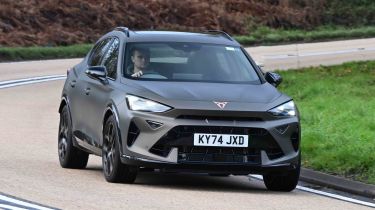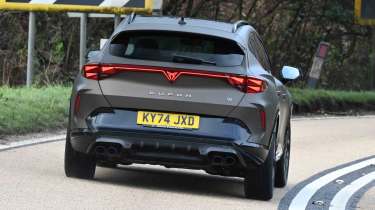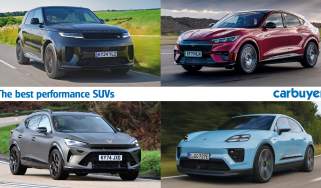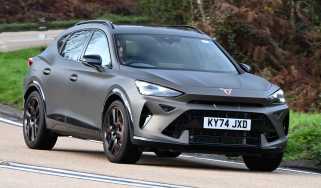Cupra Formentor review - Engines, drive & performance
The range-topping Cupra Formentor’s petrol engine is very powerful and there’s plenty of grip
The Formentor certainly looks fast, with deep creases and a sleek shape, and its appearance is backed up by scorching performance higher up in the range – even the previous top-of-the-line 306bhp petrol version has been replaced with a 328bhp facelifted model. However, while lesser variants of the Formentor can’t quite match fully-fledged hot SUVs for outright pace, all are pretty accomplished to drive.
We’ve now driven the latest facelifted Formentor in top-spec VZ3 guise with that most potent engine. The biggest takeaway from our time with it is the fact that despite being the most hardcore of the range, it still feels like Cupra has achieved the perfect balance between sportiness and comfort – at least in its normal driving modes. It’s fun to drive, but as soon as you want it to be more forgiving and easy to live with, it is. Our model came with Dynamic Chassis Control (DCC), which meant the suspension could go softer for situations such as motorway driving, making it a comfortable cruiser. Wind and road noise are kept to a minimum, and at a cruise the engine noise dies down to just a faint rumble.
Everything gets more intense when you put the car into Cupra mode, which can be accessed via a mode select button on the steering wheel. The steering becomes heavier, the throttle response is sharper, the suspension is stiffer and the augmented engine noise becomes a lot more menacing. While the car definitely feels sharpest in Cupra mode, the ride is so firm that you won't want to be in it for day-to-day driving.
More reviews
In-depth reviews
In fact, one of our main qualms was the fact that the Formentor’s 2.0-litre petrol engine is perhaps too quiet. As punchy as it is, its soundtrack is rather uninspiring and doesn’t quite have the exotic edge of that of a sports car.
A chunk more expensive is the Porsche Macan which, in our opinion, is one of the best-handling SUVs you can buy. The Formentor may not have the overall agility or composure of Stuttgart’s finest, but it isn’t all too far off and even puts potential rivals such as the Alfa Romeo Stelvio to shame.
Opt for a car with four-wheel drive and the Formentor offers an incredible amount of grip, however, all versions impressed us with their lack of body roll during cornering. There may not be a huge amount of steering feel, but this is commonplace in sporty SUV rivals and doesn't get in the way of having fun.
Cupra Formentor petrol engines
Those searching for a hot SUV experience should look no further than the range-topping 2.0-litre petrol engine. Following the Formentor’s facelift, this now produces a punchy 328bhp and will propel it from 0-62mph in a hot hatch-rivalling 4.8 seconds. While not as characterful as, say, the five-cylinder unit in the latest Audi RS3, the 2.0-litre powerplant offers plenty of power. While its soundtrack isn’t the most exciting, that may count towards its appeal for some buyers as it’s easy to live, settles down at cruising speeds and isn’t overly obnoxious.
With 148bhp and the choice of a six-speed manual gearbox or optional seven-speed DSG automatic (the latter of which gets mild-hybrid assistance), the entry-level 1.5-litre TSI is another familiar engine. It's a stalwart of the Golf range for a start and here it gets the Formentor from 0-62mph in 8.9 seconds, with a top speed of 127mph. This is a fairly quiet engine, and considering it does its best work in the mid-range, there's little reason to work it too hard.
Hybrid engines
Before the facelift, the two PHEV versions used a 1.4-litre petrol turbo engine and electric motor, with either 201 or 242bhp. These get the Formentor from 0-62mph in 7.8 and seven seconds respectively – not especially quick by hot SUV standards. It doesn't sound very inspiring if you accelerate hard, but in Cupra mode the sound system will take over and reproduce a five-cylinder engine noise – something that can be perceived as cool or kitsch, depending on your personal tastes. Following the facelift these are being replaced by plug-in systems with a 1.5-litre engine and electric motor – these combine to produce either 201bhp or 268bhp, with 0-62mph taking 7.9 seconds and 7.2 seconds respectively.
Unfortunately, the extra weight of the battery pack is rather noticeable and stiffer suspension has been fitted to help cope with it. This results in a less agile feeling and the ride isn’t quite as good either.
The hybrids may not be the best choice for those looking for the most performance but their electric driving range should mean most drivers can cover off their commute without using any petrol at all.












